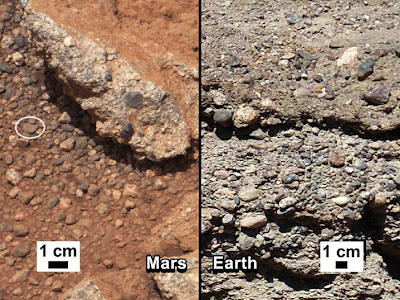 |
| A sinistra: i ciottoli marziani; a destra comuni ciottoli terrestri (vedi anche forto ingrandita nel testo inglese, sotto) |
Marte era un pianeta ricco di acqua: trovati ciottoli levigati in un antico fiume
Su Marte scorrevano fiumi: la prova definitiva viene dalla scoperta di alcuni ciottoli levigati del tutti simili a quelli che sulla Terra si trovano lungo i corsi d'acqua. Li ha fotografati e analizzati il robot laboratorioCuriosity della Nasa, che dal 6 agosto scorso sta esplorando il cratere Gale. L'annuncio viene fatto sulla rivista Science dai geologi americani guidati da Rebecca Williams, dell'Istituto di scienze planetarie di Tucson, in Arizona. I ciottoli, mescolati con della sabbia a formare dei conglomerati rocciosi, sono stati individuati tra il margine settentrionale del cratere Gale e la base del monte Sharp che si trova al centro del cratere stesso. Secondo le analisi dei geologi, la loro forma e le loro dimensioni sono tipiche dei sassi trasportati
I ciottoli sarebbero stati depositati circa 2 miliardi di anni fa - Si trovavano in un ruscello che doveva avere una profondità tra i 3 e i 90 centimetri e una velocità compresa fra 0,2 e 0,75 metri al secondo. In passato erano già stati trovati indizi che suggerivano la presenza di acqua sul pianeta rosso: lo scorso settembre, ad esempio, Curiosity aveva scoperto una roccia scavata dallo scorrere dell'acqua. Questi ciottoli, però, rappresentano una prima assoluta. ''E' la prima volta che osserviamo della ghiaia trasportata dall'acqua su Marte'', spiega William Dietrich dell'università della California a Berkeley. ''Un corso d'acqua duraturo può rappresentare un ambiente abitabile'', aggiunge John Grotzinger del California Institute of Technology (CalTech)a Pasadena. ''Ora ci muoveremo verso il monte Sharp alla ricerca di tracce organiche, ma questo ci assicura che abbiamo già trovato il nostro primo ambiente
31 maggio 2013
Redazione Tiscali
Pebbly rocks testify to old streambed on Mars
Detailed analysis and review have borne out researchers' initial interpretation of pebble-containing slabs that NASA's Mars rover Curiosity investigated last year: They are part of an ancient streambed.
The rocks are the first ever found on Mars that contain streambed gravels. The sizes and shapes of the gravels embedded in these conglomerate rocks -- from the size of sand particles to the size of golf balls -- enabled researchers to calculate the depth and speed of the water that once flowed at this location.
"We completed more rigorous quantification of the outcrops to characterize the size distribution and roundness of the pebbles and sand that make up these conglomerates," said Rebecca Williams of the Planetary Science Institute, Tucson, Ariz., lead author of a report about them in the journal Science this week. "We ended up with a calculation in the same range as our initial estimate last fall. At a minimum, the stream was flowing at a speed equivalent to a walking pace -- a meter, or three feet, per second -- and it was ankle-deep to hip-deep."
Three pavement-like rocks examined with the telephoto capability of Curiosity's Mast Camera (Mastcam) during the rover's first 40 days on Mars are the basis for the new report. One, "Goulburn," is immediately adjacent to the rover's "Bradbury Landing" touchdown site. The other two, "Link" and "Hottah," are about 165 and 330 feet (50 and 100 meters) to the southeast. Researchers also used the rover's laser-shooting Chemistry and Camera (ChemCam) instrument to investigate the Link rock.
"These conglomerates look amazingly like streambed deposits on Earth," Williams said. "Most people are familiar with rounded river pebbles. Maybe you've picked up a smoothed, round rock to skip across the water. Seeing something so familiar on another world is exciting and also gratifying."
 |
| This set of images compares the Link outcrop of rocks on Mars (left) with similar rocks seen on Earth (right) [Credit: NASA/JPL-Caltech/MSSS and PSI] |
The larger pebbles are not distributed evenly in the conglomerate rocks. In Hottah, researchers detected alternating pebble-rich layers and sand layers. This is common in streambed deposits on Earth and provides additional evidence for stream flow on Mars. In addition, many of the pebbles are touching each other, a sign that they rolled along the bed of a stream.
"Our analysis of the amount of rounding of the pebbles provided further information," said Sanjeev Gupta of Imperial College, London, a co-author of the new report. "The rounding indicates sustained flow. It occurs as pebbles hit each other multiple times. This wasn't a one-off flow. It was sustained, certainly more than weeks or months, though we can't say exactly how long."
The stream carried the gravels at least a few miles, or kilometers, the researchers estimated.
The atmosphere of modern Mars is too thin to make a sustained stream flow of water possible, though the planet holds large quantities of water ice. Several types of evidence have indicated that ancient Mars had diverse environments with liquid water. However, none but these rocks found by Curiosity could provide the type of stream flow information published this week. Curiosity's images of conglomerate rocks indicate that atmospheric conditions at Gale Crater once enabled the flow of liquid water on the Martian surface.
During a two-year prime mission, researchers are using Curiosity's 10 science instruments to assess the environmental history in Gale Crater on Mars, where the rover has found evidence of ancient environmental conditions favorable for microbial life.
More information about Curiosity is online at: http://www.jpl.nasa.gov/msl ,http://www.nasa.gov/msl and http://mars.jpl.nasa.gov/msl/ .
Source: NASA/Jet Propulsion Laboratory [May 30, 2013]


